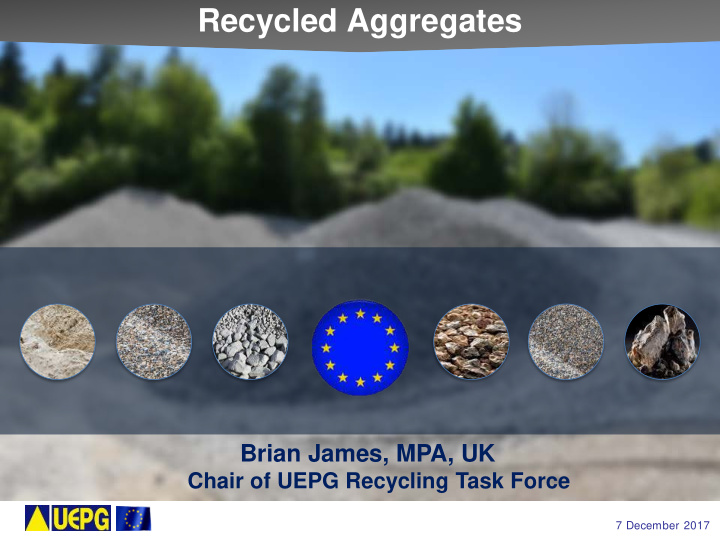



Recycled Aggregates Brian James, MPA, UK Chair of UEPG Recycling Task Force 7 December 2017
UNI ON EUROPÉENNE DES PRODUCTEURS DE GRANULATS EUROPÄI SCHER GESTEI NSVERBAND EUROPEAN AGGREGATES ASSOCI ATI ON Belgian association of non-energy extractive industries Production of aggreggates (limestone, sandstone, porphyry, sand, gravels, marine aggregates), lime, dolomie, ornamental stones Since 1987, UEPG is strongly promoting the interests of the European Aggregates I ndustry and has members in 27 countries in Europe 7 December 2017 7 December 2017
What are aggregates Sand Gravel Crushed Rock Marine Aggregates Recycled Aggregates Manufactured Aggregates 7 December 2017
Recycled Aggregates Recycled Aggregates (mt), 2015 80 70 60 50 40 30 20 10 0 UK Austria Hungary Germany Netherlands France Belgium Poland Italy Norway Denmark Finland Bulgaria Spain Slovakia Greece Malta Portugal Luxembourg Switzerland 7 December 2017
Circular Economy • UEPG supports the concept of circular economy and the use of the waste hierarchy, including recycling where technically, environmentally and economically feasible . 7 December 2017
Circular Economy • UEPG has actively contributed to the development of the EU Construction and Demolition Waste Management Protocol which was published in November 2016 UEPG officially endorsed the EU Construction and Demolition Waste Management Protocol which constitutes a significant contribution to the efforts towards an EU Circular Economy Model and supports the European Commission in promoting its application . 7 December 2017
I n practice…. The available amount of recycled aggregates • of the appropriate quality , would not allow for the complete substitution of natural aggregates . • Even with 100% recycling of all construction and demolition waste, it would cover only 12 to 20% of the current total demand of aggregates . 7 December 2017
Objectives • Promote optimal construction design to ensure longest possible lifespan, to minimise initial material use, to have a built-in adaptability and minimal end- of-life demolition; Make sure that natural and recycled aggregates • are subject to the same environmental and quality criteria in their respective applications Promote the collation of accurate statistics to • show the availability of recycled aggregates to benchmark the improvements of use made by individual Member States • Transfer of knowledge and exchange of good practice examples 7 December 2017
Necessities to go forward • Work with the political and regulatory bodies to determine what kind of measures to promote recycled aggregates would work best in each Member State. • To support Member States in their ambitions to use more recycled aggregates in appropriate applications or to maintain higher recycling rates. This implies the promotion of recycled aggregates where • economically , environmentally and technically feasible respecting the given technical standards. • This includes also the education of customers on the benefits of using recycled materials and changing the public perception. 7 December 2017
THANK YOU 7 December 2017
Recommend
More recommend